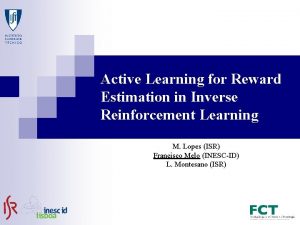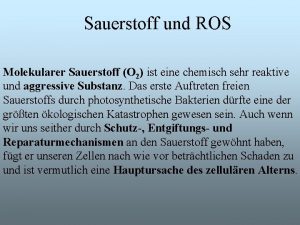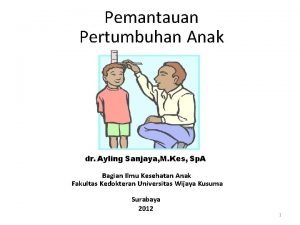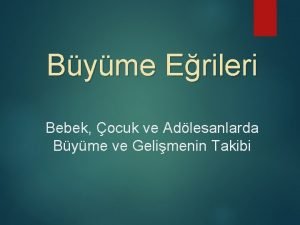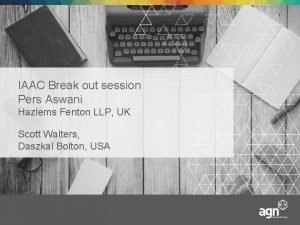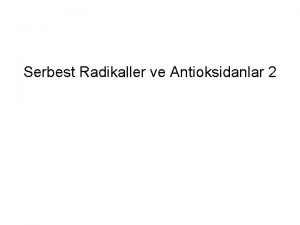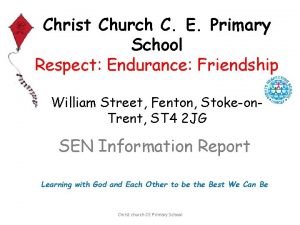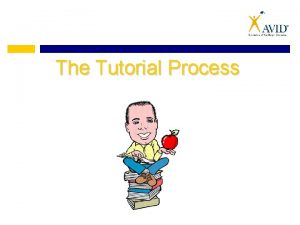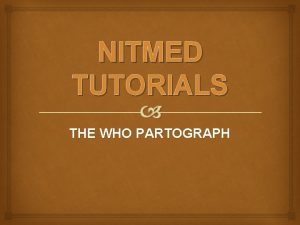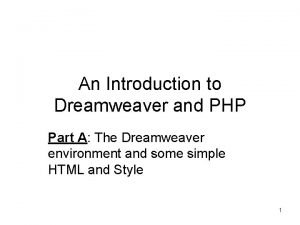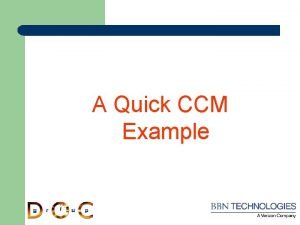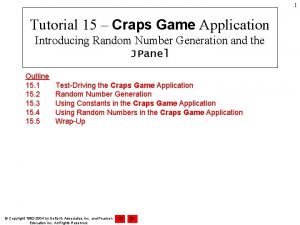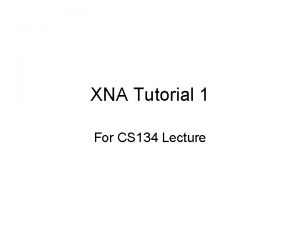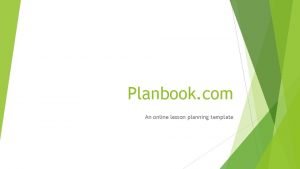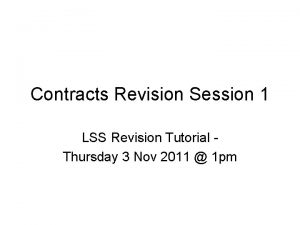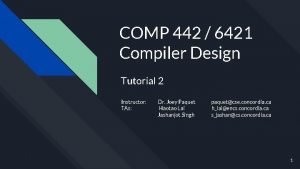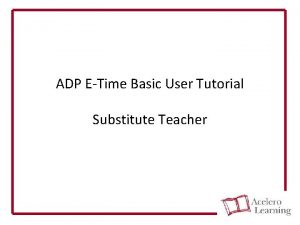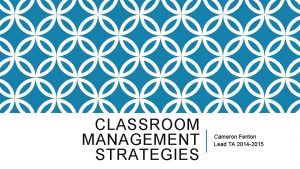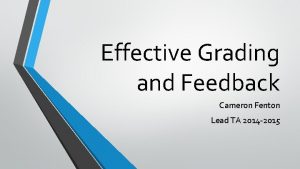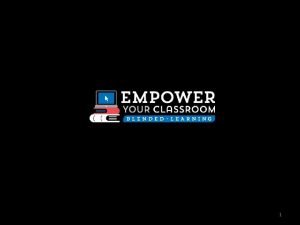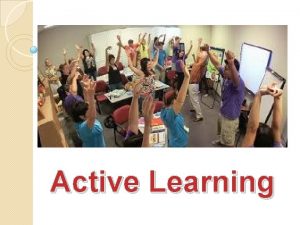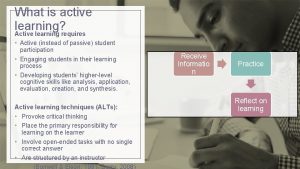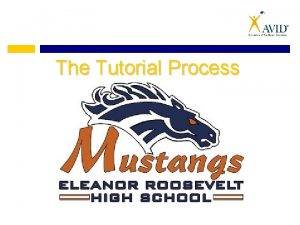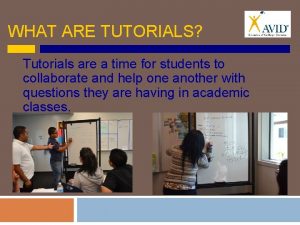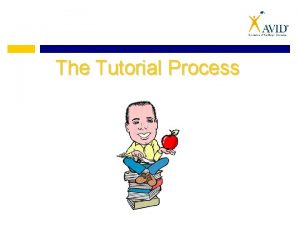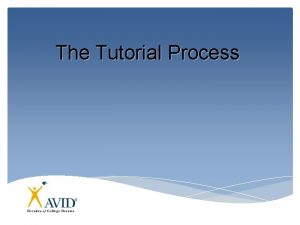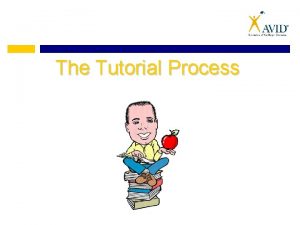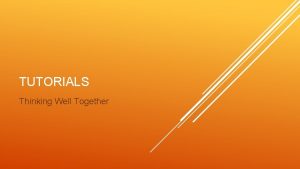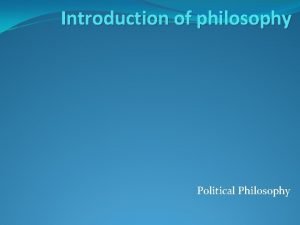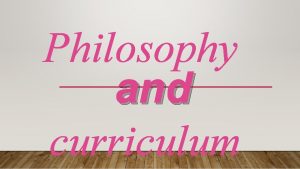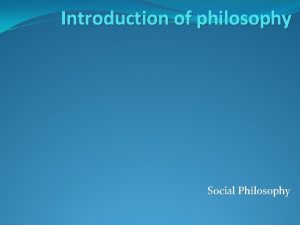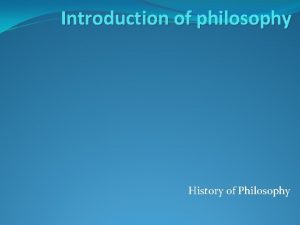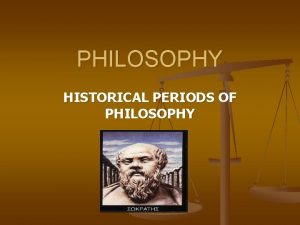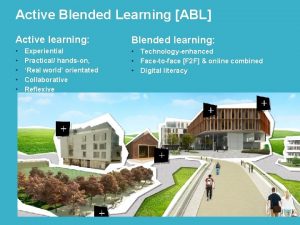Active Learning in Philosophy Tutorials Cameron Fenton Lead































- Slides: 31

Active Learning in Philosophy Tutorials Cameron Fenton Lead TA 2014 -2015

Agenda • 1. What is Active Learning? • 2. Why Use Active Learning? • 3. Practice! • Hint: You may want to take brief notes during the first two sections.

Words of Wisdom from Thiagi • “Always remind yourself that your task is not to merely cover the content, but to help participants actively discover, understand, retain, recall, apply, and get excited about new principles and procedures. ”

Active Learning • Active learning is all about student engagement with the learning process. It usually involves getting students to do some kind of activity and reflect on what they have learned.

Why Active? • Active learning is usually contrasted with passive learning. In a university setting, lecturing is the most common form of passive learning. • During a lecture, students passively receive information from the instructor. It is a one-way learning process in which an expert imparts knowledge onto non-experts.

What’s Wrong With Lecturing? • Nothing, but… • Using active learning in your classroom doesn’t mean you can’t ever lecture. In fact, you should have some time devoted to lecturing. What you want to get away from is only lecturing. • Some people are amazing speakers and can hold an audience’s attention just by lecturing. These people are rare and you probably aren’t one of them. • It’s really boring to listen to someone talk for an hour without some kind of activity. When people get bored it becomes much more difficult for them to focus and learn.

Engagement • You want your students to be engaged with the material you are trying to teach them. If you can get them talking, writing, drawing, or playing during your lesson, then you’ve got a much better chance of keeping them engaged. • It’s a lot harder to zone out on Facebook or fall asleep if you have a task to complete.

Engagement Assists Learning • A study by Laws et al. of 6000 students in an introductory physics course examined the effects of interactive engagement methods. • Test scores measuring conceptual understanding were roughly twice as high in the classes that used interactive engagement methods than in classes that used traditional lectures.


Advantages of Active Learning • Discussion surpasses traditional lectures for student retention of material, motivation for future study, and the development of thinking skills. (Bonwell and Eison 1991) • Breaking up a lecture with an activity can reset students’ attention span. The average student has a lecture attention span of 15 minutes, after that student attention drops off rapidly resulting in low retention of lecture material. Students can remember about 70% of material from the first ten minutes of a lecture, but only about 20% from the last ten minutes. (Wankat 2002 and Hartley and Davies 1978)

Collaboration • Active learning methods often involve student collaboration. • Johnson, and Smith in a review of 168 studies from 1924 -1997 found that collaboration consistently improved learning outcomes relative to individual work. Roughly, students who would score in the 50 th percentile on an exam without collaboration during class improved to the 70 th percentile with collaboration during class.

Thinkers • One of your goals in any philosophy class is probably to make your students better critical thinkers. Lecturing is a good way to convey information in one direction, but it probably won’t get many of your students thinking critically about what you’re conveying to them. • Active learning gets the students involved in the learning process and allows them to learn from each other.

Why Active Learning is Good for You • Unless you are an experienced lecturer, you probably have to do a fair amount of preparation for your lesson. It takes a lot of material to talk for an hour. • Using activities allows you to prepare less material. Questions will naturally come out of the activities and these can lead to class or group discussions. The activities themselves also take time, which gives you a chance to prepare for the next section of the lesson.

Caution • Activities won’t help if they don’t have a goal. Random activities just to break up a lecture are unlikely to help. Good activities emphasize understanding the important ideas students are expected to learn. • If you use learning outcomes to design your lessons, then your activities should correspond to a particular learning outcome. If you don’t use learning outcomes to design your lessons, then think carefully about the purpose of an activity.

Push Back • You will almost certainly get students who don’t want to participate or think activities are a waste of time. • That’s fine, you can’t force them to participate, but in my experience most people come around if they actually try the activities.

Practice • For the majority of the rest of the workshop we’re going to practice active learning methods. • My learning outcome for these activities is just to help you understand how the activities work. They will include silly questions that I hope you can answer rather quickly. When using them in a tutorial, you’ll likely want to give students more time as the questions will likely have more difficult/controversial answers.

Active Learning Exercises: Best Summaries • Best Summaries: Each student prepares a summary of the main points that have been covered so far in the session. Students then form small groups, shuffle the summaries and pass their summaries to another group. Each group then selects the best summary from the pile. The instructor then asks each group to read the best summary. The instructor can then collect and post the best summaries on the class website for everyone to use. • Advantages: Rewards good note taking, encourages reflection on the material, very easy to use.

Quick Note • It’s generally a good idea to tell students you will be asking them to write summaries at various points during the lecture. This will encourage them to take notes and will avoid taking them by surprise.

Practice Best Summaries • • • Topic: Summarize what I’ve said about the benefits of active learning. Step One: Write your own summary on a piece of paper. (2 minutes) Step Two: Form a group of three or four and exchange your summaries with another group. (1 minute) Step Three: As a group, pick the best summary. (3 minutes) Step Four: I’ll ask one person from each group to read the best summary. (2 minutes) Step Five: I’ll collect the best summaries. (1 minute)

Active Learning Exercises: Think Pair Share • Think Pair Share: Students think about a question or concept individually, then they pair up with another student to discuss their ideas. The instructor then selects a few pairs to share what they discussed with the larger group. • Advantages: Works with any group size, no resources required, everyone gets to participate, can be very quick.

Practice Think Pair Share • Question: Who is your favorite philosopher, and why? • Step One: Think about this on your own (1 minute) • Step Two: Pair up and discuss (2 minutes) • Step Three: I’ll pick two pairs to share (2 minutes)

Active Learning Exercises: Snowball • Snowball: Everyone individually writes down their top three questions/comments/answers to something asked by the instructor. Students then pair up and choose the top three from their combined responses. The pairs then join with another pair to form a group of four and the group chooses the top three responses. • Advantages: Great for creating lists of best questions/comments/answers, requires student interaction and compromise, allows students to see peer ideas.

Practice Snowball • Question: What were three best movies of 2014? • Step One: Write down your answers individually (2 minutes) • Step Two: Get into pairs and agree on three answers (3 minutes) • Step Three: Get into groups of four and agree on three answers (3 minutes) • Step Four: I’ll ask a few groups of four to share their answers. (2 minutes)

Active Learning Exercises: Quescussion • Quescussion: This activity helps generate a list of questions that people might ask about a particular topic. The instructor starts by asking a question and everyone is invited to yell out another question. All responses must be questions. If someone makes a statement, then everyone else yells “statement!”. Let at least two other people yell out a question before you offer another. • Advantages: Can be a lot of fun, gets people thinking about questions, gives you an idea of what students are thinking about.

Practice Quescussion • Topic: Questions students might ask on the first day of class • Step One: Yell out questions! (5 minutes)

Active Learning Exercises: Superlatives • Superlatives: The instructor asks students to identify the most interesting, confusing, troubling, exciting, boring, etc. , concept or fact mentioned in the lecture. Students then pair up can compare their lists. The instructor may collect the lists to get insight into what the students are taking away from a particular lecture. • Advantages: A great way to get feedback on what students are thinking about, quick and repeatable, can be used to figure out what needs more attention in future lectures.

Practice Superlatives • Make a list of the most difficult to understand, humorous, controversial, intriguing, obvious, surprising, and unusual facts or concepts in my earlier lecture. • Step One: Make your list. You don’t have to write something for every category if you don’t think anything fits. (3 minutes) Step Two: Pair up and compare your lists. (3 minutes) Step Three: I’ll collect the lists. (1 minute) • •

Activity: Design • I’d like you to take whatever time is left to design your own active learning activity in groups of three or four. It can be a variation on one of the activities we talked about today or it can be something new. • We’ll talk about them when everyone is finished, if there’s time.

Sample Activities For Intro to Philosophy • Snowball: What is the most important difference between Mill and Bentham on utilitarianism? • Think Pair Share: What was the most interesting paper we read during our unit on epistemology? • Superlatives: What was the most _____ fact or concept you learned during our unit on political philosophy?

Sample Activities for Critical Thinking • Best Summaries: Get students to write a summary right after you explain the difference between inductive and deductive arguments. • Quescussion: During one of the first classes ask students what questions they have about critical thinking. This allows you to gauge their interest. • Superlatives: Get students to list their most confusing or difficult concepts from the course. This will give you a better idea of what they are having trouble with.

Feedback • Please fill out a feedback form before leaving, it really helps. • Thanks for attending!
 Philosophy active learning
Philosophy active learning Active and passive learners
Active and passive learners Active learning reinforcement learning
Active learning reinforcement learning Lead magnesium niobate
Lead magnesium niobate Fenton reaktion
Fenton reaktion Dr ayling
Dr ayling Fenton chemistry
Fenton chemistry Fenton büyüme eğrileri
Fenton büyüme eğrileri Reazione di fenton
Reazione di fenton Pers aswani
Pers aswani Deaminazione adenina
Deaminazione adenina Acino di rappaport
Acino di rappaport Miss fenton
Miss fenton Optimisation
Optimisation Fenton's reagent is
Fenton's reagent is Fenton reaksiyonu
Fenton reaksiyonu James fenton in paris with you
James fenton in paris with you Christ church primary school fenton
Christ church primary school fenton Cuadro comparativo e-learning b-learning m-learning
Cuadro comparativo e-learning b-learning m-learning One question the tutorial sparked for you
One question the tutorial sparked for you Nitmed tutorials
Nitmed tutorials Macromedia dreamweaver 8 tutorial
Macromedia dreamweaver 8 tutorial Flash dreamweaver templates
Flash dreamweaver templates Web authoring using adobe dreamweaver - selected response
Web authoring using adobe dreamweaver - selected response Ccm examples
Ccm examples Craps tutorial
Craps tutorial Xna game tutorial
Xna game tutorial Zemax thermal analysis
Zemax thermal analysis Online planbook
Online planbook Lss software tutorials
Lss software tutorials Compiler design tutorial
Compiler design tutorial Adp payroll tutorial
Adp payroll tutorial


